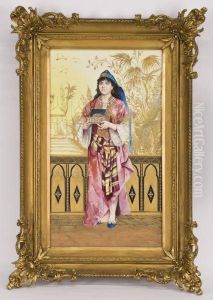Felix Lecomte Paintings
Felix Lecomte was a French sculptor born on October 19, 1737, in Pithiviers, France. He was noted for his classical and mythological sculptures, which were very much in vogue during his time, especially prior to the French Revolution. Lecomte's works reflect the transition from the Rococo style, which was ornate and asymmetrical, to the more restrained and symmetrical Neoclassical style that was inspired by the art and architecture of ancient Greece and Rome.
Lecomte received his early training in the arts in his hometown and later moved to Paris to further his education. He became a student of the prominent sculptor Jean-Baptiste Pigalle and later, Jean-Baptiste Lemoyne, both of whom had significant influence on his artistic development. Lecomte's skill and talent were recognized early in his career, and he gained admission to the prestigious Académie Royale de Peinture et de Sculpture in 1769. As was typical for artists of his time, Lecomte sought the patronage of the aristocracy and the French monarchy, which provided him with commissions and financial support.
The artist's career prospered in the years leading up to the French Revolution. He produced portrait busts, statues, and relief panels, exhibiting his works at the Salon, the official art exhibition of the Académie Royale. His sculptures often featured figures from classical mythology, such as nymphs, satyrs, and gods, which were popular subjects for decorative arts during the period.
However, the turmoil of the French Revolution had a profound impact on artists like Lecomte. The societal upheaval and the decline of the aristocracy led to a reduction in commissions and a change in artistic trends. Despite these challenges, Lecomte continued to work and adapt to the changing times. After the Revolution, he produced works that aligned more with the republican values and the rise of Napoleon Bonaparte, which included portrayals of contemporary figures and national heroes.
Felix Lecomte's contributions to French sculpture were recognized by his contemporaries, and his legacy lived on in the artists who followed him, many of whom were influenced by the Neoclassical style that he helped to popularize. Lecomte passed away on May 12, 1817, in Paris, leaving behind a body of work that continues to be appreciated for its elegance, craftsmanship, and historical significance.
